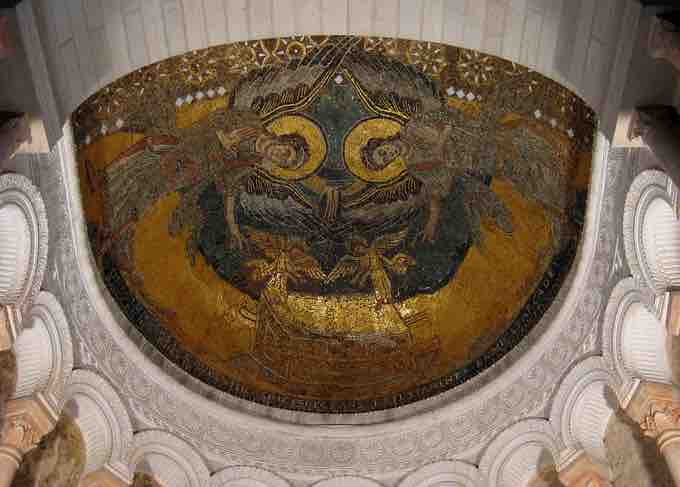Background
Carolingian art comes from the Frankish Empire in the period of roughly 120 years from about 780 to 900 CE — during the reign of Charlemagne and his immediate heirs — popularly known as the Carolingian Renaissance. The art was produced by and for the court circle and a group of important monasteries under imperial patronage.
Surviving examples of painting from this era consist mainly of frescoes and mosaics produced in present-day France, Germany, Switzerland, Austria, northern Italy, and the Low Countries. These sites have given art historians some material to study in order to theoretically conceptualize Carolingian paintings. Paintings show an attempt to conform to Charlemagne's desire to revive the Roman Empire under a Christian banner. The figures in the frescoes, although relatively flat and posed in a stylized manner, display a degree of modeling and an acknowledgement of the body beneath the clothing. Their facial expressions and body language imply a sense of interaction, although few stand in profile, and none seem to turn their backs to the viewer. Surviving frescoes show a greater degree of modeling, a variety of poses, and a relatively naturalistic rendering of draperies and an acknowledgement of the bodies beneath. Outside the elite circle that produced these works, however, the quality of visual art was of a much lesser quality.
Frescoes
Various forms of Carolingian painting also includes frescoes that reached a pinnacle of production under the reign of Charlemagne. A villa to which the oratory of the Palatine Chapel was attached belonged to Bishop Theodulf of Orléans, a key associate of Charlemagne. It was destroyed later in the century, but contained multiple Carolignian frescos of the Seven Liberal Arts, the Four Seasons, and the Mappa Mundi (Map of the World). Art historians have found that there were numerous other Carolingian frescoes in churches and palaces that have since been nearly completely lost.
The Abbey of Saint John at Müstair, Switzerland is the site of exceptionally well-preserved Carolingian art. The original church has several significant early medieval frescoes from around 800. The paintings are organized in five rows that stretch from the southern wall across the west wall to the northern wall. The top row features scenes from the life of King David of the Old Testament. The next three rows show scenes from the youth, life, and Passion of Christ. The bottom row contains scenes from the crucifixion of Saint Andreas. On the western wall the rows are tied together with an image of the Last Judgment. The palette consists of a limited range of colors including ochre, red, and brown.
Fragments of Carolingian-era frescoes (early ninth century), St. John at Müstair
Art historian Dr. Bernd Schälicke examines the Carolingian frescoes on the north wall of the Benedictine Monastery Church of St. John at Müstair.
The frescoes at Saint Benedikt at Mals, Italy are contemporary with those at neighboring Saint John at Müstair. They belong to a limited set of surviving frescoes of the Carolingian period. The frescoes are mostly distributed in three niches in the altar wall, showing Jesus Christ in the center, flanked by pope Gregory the Great and Saint Stephen. On the walls separating the niches are donor portraits below a troop of twelve angels, and scenes showing Gregory writing his Dialogi and disputing with Paulus Diaconus (Paul the Deacon), alongside scenes showing Paul of Tarsus and a fragment of a scene from the life of Saint Benedict.
Saint Gregory Disputing with Paulus Diaconus (c. 825).
Church of St. Benedict, Mals, Italy.
Mosaics
Mosaics were created by assembling small pieces of colored glass, stone, pigments, and other materials. The mosaics were created in Charlemagne's Palatine Chapel at Aachen, whose interior remains adorned with arch-to-dome mosaics. Like the Byzantine mosaics that influenced their design, those that adorn Charlemagne's chapel feature floral motifs and classicized figures in a variety of poses against largely gold backgrounds.
Palatine Chapel at Aachen, interior view
The surviving mosaics begin above eye level at the piers or arches and span upward into the dome.
The most famous mosaic in Charlemagne's chapel showed an enthroned Christ, worshiped by the Evangelist's symbols and the 24 elders of the Apocalypse. This mosaic no longer survives, but a restored one remains in the apse of the oratory at Germigny-des-Prés (806), which was discovered in 1820 under a coat of plaster, and shows the Ark of the Covenant adored by angels.

Ark of the Covenant, Germigny-des-Prés (c. 806)
Restoration of the original that once adorned the Palatine Chapel. The subject seems drawn from illuminated Jewish bibles, and relates to the Libri Carolini, possibly written by Theodulf, where the Ark is cited as divine approval of sacred images.